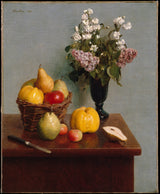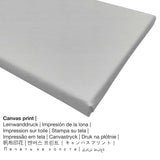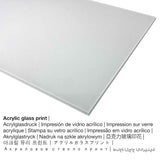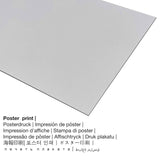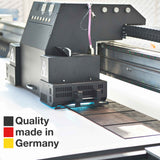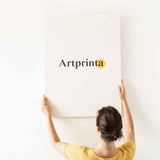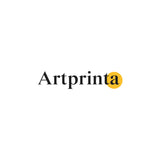Henri Fantin-Latour, 1866 - Ndụ ka nwere ifuru na mkpụrụ - mbipụta nka mara mma.
Ụtụ gụnyere. Mbupu gbakọrọ na ndenye ọpụpụ.
Nchịkọta edemede
"Still Life with Flowers and Fruit" is a painting by the realist French onye na-ese ihe Henri Fantin-Latour. The original was made with the size - 28 3/4 x 23 5/8 in (73 x 60 cm). Mmanụ na kwaaji was applied by the European painter as the technique for the masterpiece. Nowadays, this work of art can be viewed in in the The Metropolitan Museum of Art's art collection, which is located in New York City, New York, Njikota Obodo Amerika. The nkà nke oge a ngalaba ọha artwork na-nyere na n'ikike nke The Metropolitan Museum of Art, New York, Ịzụta, Mr. na Oriakụ Richard J. Bernhard Onyinye, site mgbanwe, 1980. : Ịzụta, Mr. na Oriakụ Richard J. Bernhard Onyinye, site mgbanwe, 1980. Na mgbakwunye na nke a, nhazi nke mmepụta dijitalụ dị na eserese format ya na oke nke 1: 1.2, nke pụtara na ogologo bụ 20% mkpụmkpụ karịa obosara. Henri Fantin-Latour was a male painter, graphic artist, botanical illustrator, lithographer from France, whose artistic style can primarily be assigned to Realism. The European artist was born in the year 1836 in Grenoble, Auvergne-Rhone-Alpes, France and deceased at the age of 68 in the year 1904.
Họrọ nhọrọ akụrụngwa ngwaahịa
The product dropdown menu ofers you the chance to pick a material and a size of your choice. We allow yout to choose among the following variants:
- Mpempe akwụkwọ (ihe kwaaji): Our poster print is a printed flat canvas with a granular texture on the surface. The poster print is suited for putting the art copy using a custom frame. Please note, that depending on the absolute size of the poster print we add a white margin of around 2-6cm around the work of art, which facilitates the framing with your custom frame.
- Mbipụta iko acrylic (nke nwere ezigbo mkpuchi iko): An acrylic glass print, which is sometimes referred to as a plexiglass print, transforms your favorite artwork into lovely décor. The work of art is made thanks to the help of modern UV printing machines. It makes vivid, stunning colors. Our plexiglass with real glass coating protects your chosen fine art print against sunlight and heat for up to six decades.
- Mbipụta kwaaji: The printed canvas, which shall not be mistaken with a canvas painting, is a digital copy printed on an industrial printer. A canvas produces the plastic look of three dimensionality. Furthermore, a printed canvas creates a lively and pleasing appearance. Canvas prints are relatively low in weight, meaning that it is easy and straightforward to hang up your Canvas print without additional wall-mounts. A canvas print is suited for any kind of wall.
- Mbipụta nke aluminom: Aluminium Dibond prints are metal prints with an outstanding depth effect. A direct Direct Print on Aluminum Dibond is your ideal start to art reproductions made with aluminum. The colors are vivid and luminous in the highest definition, fine details of the print appear clear and crisp, and you can notice the matte appearance of the product. This print on aluminium is one of the most demanded entry-level products and is an extremely stylish way to display fine art prints, since it draws focus on the artwork.
Disclaimer: We try whatever we can to depict our products with as many details as possible and to showcase them visually on the product detail pages. Still, the pigments of the printing material, as well as the print result can differ marginally from the image on your screen. Depending on your settings of your screen and the nature of the surface, colors may not be printed one hundret percent realistically. Given that the art prints are printed and processed by hand, there may also be minor variations in the motif's exact position and the size.
Ozi ndabere ngwaahịa
| Ụdị ngwaahịa: | mmepụta nka |
| Mmeputakwa: | dijitalụ mmeputakwa |
| Usoro mmepụta: | Mbipụta UV ozugbo (mbipụta dijitalụ) |
| Mmalite nke ngwaahịa a: | Germany |
| Ụdị ngwaahịa: | mmepụta ihe na-achọ |
| Eji ngwaahịa emebere: | nka mgbidi, ihe ndozi ụlọ |
| Nhazi onyonyo: | nhazi ihe osise |
| Ụdị anya: | 1: 1.2 |
| Ihe: | ogologo bụ 20% mkpụmkpụ karịa obosara |
| Ụdị dị iche iche dị: | Mbipụta iko acrylic (nke nwere ezigbo mkpuchi iko), mbipụta kanvas, mbipụta ọla (aluminium dibond), mbipụta akwụkwọ mmado (akwụkwọ kwaaji) |
| Kanvas n'elu etiti ihe ndọtị (mbipụta akwa akwa): | 50x60cm - 20x24", 100x120cm - 39x47", 150x180cm - 59x71" |
| Mbipụta iko acrylic (nwere ezigbo mkpuchi iko) nhọrọ nha: | 50x60cm - 20x24", 100x120cm - 39x47", 150x180cm - 59x71" |
| Nhọrọ nha nke akwụkwọ mmado (akwụkwọ kwaaji): | 50x60cm - 20x24", 100x120cm - 39x47" |
| Nhọrọ nha nha nke Dibond (ihe alumnium): | 50x60cm - 20x24", 100x120cm - 39x47" |
| Igwe onyonyo: | agunyeghi |
Tebụl ihe osise
| Aha nka: | "Ndụ ka nwere okooko osisi na mkpụrụ" |
| Nhazi nka nka: | sere |
| Okwu mkpokọta: | nkà nke oge a |
| Century: | 19th narị afọ |
| Emepụtara n'afọ: | 1866 |
| Afọ nka: | karịa afọ 150 |
| Agba na: | mmanụ na kwaaji |
| Nha nke ihe osise izizi: | 28 3/4 x 23 5/8 na (73 x 60 cm) |
| Ụlọ ihe ngosi nka / ebe: | Museumlọ ihe ngosi nka nke Obodo |
| Ebe ngosi nka: | New York City, New York, Njikota Obodo Amerika |
| website: | Museumlọ ihe ngosi nka nke Obodo |
| Ụdị nka nka: | ngalaba ọha |
| Site n'aka: | The Metropolitan Museum of Art, New York, Ịzụta, Mr. na Oriakụ Richard J. Bernhard Onyinye, site mgbanwe, 1980 |
| Ebe kredit nke ọrụ nka: | Ịzụta, Mr. na Oriakụ Richard J. Bernhard Onyinye, site mgbanwe, 1980 |
Tebụl onye na-ese ihe
| aha: | Henri Fantin-Latour |
| Aha ndi ozo: | h.j.t. fantin latour, latour henri fantin, Fantin-Latour Ignace Henri Jean Theodore, Henri-Théodore Fantin-Latour, Fantin-Latour Henri-Théodore, Fantin-Latour J.-H., Latour Henri Fantin-, H. Fantin Latour, H. Fantin-Latour, fantin latour henri, Henri Fantin-Latour, fantin latour henri, Fantin, I. H. J. Th. Fantin-Latour, פנטין לאטור אנרי, fantin latour h.j.t., latour fantin, h.j.t.f. latour, Ignace Henri J. Th. Fantin-Latour, Fantin-Latour Ignace Henri, Fantin Latour, Ignace Henri Jean Theodore Fantin-Latour, Fantin-Latour Ignace-Henri-Jean-Théodore, Fantin-Latour, Fantin-Latour Henri, Fantin-Latour Ignace-Henri Jean Theodore, J. Th. fantin-latour |
| okike nke onye nka: | nwoke |
| Obodo onye nka: | French |
| Ọrụ: | onye na-ese ihe, onye na-ese ihe, onye na-ese ihe, onye na-ese ihe ọkụkụ |
| Obodo onye nka: | France |
| Otu nka: | omenkà nke oge a |
| Ụdị nka: | Ihe ngosi |
| Ndụ: | 68 afọ |
| Amụrụ n'afọ: | 1836 |
| Ebe omuma: | Grenoble, Auvergne-Rhone-Alpes, France |
| Afọ nwụrụ: | 1904 |
| Nwuru na (ebe): | Basse-Normandie, France |
© Copyright - ikike ọgụgụ isi nke | Artprinta (www.artprinta.com)
What does the The Metropolitan Museum of Art state about the artwork made by Henri Fantin-Latour? (© Nwebiisinka - nke Ụlọ ihe ngosi nka nke Obodo ukwu - www.metmuseum.org)
This is one of four still lifes commissioned from the artist by Michael Spartali, a Greek businessman and diplomat who lived in London. Fantin worked on these canvases from March through September 1866, exhibiting one of them at the Paris Salon the same year (now National Gallery of Art, Washington). Among Fantin’s first major achievements as a still life painter, the present work reflects his aspiration to create serious and complex compositions in a realist style inspired by Chardin and Courbet.

